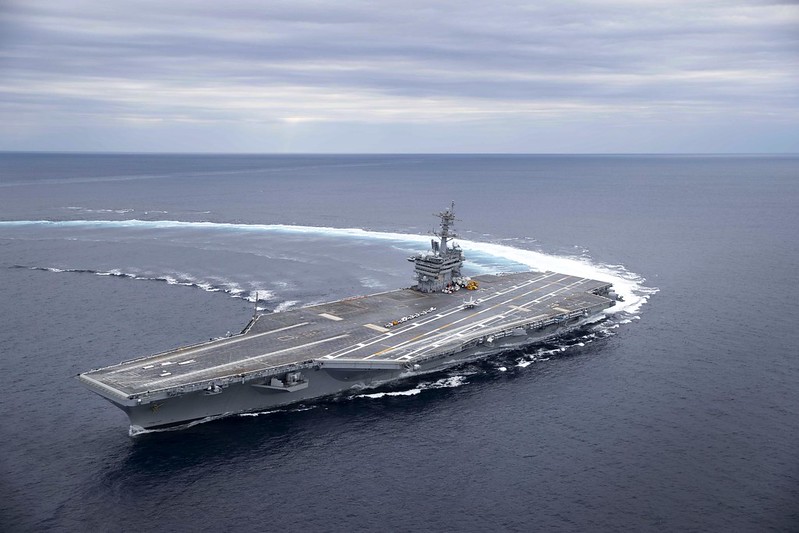
Sea state
India put its ‘strategic rivals on notice’ last week by successfully launching a test missile from INS Arihant, the Indian navy’s flagship nuclear submarine, striking a designated point in the Bay of Bengal with ‘very high accuracy’. The test was likely motivated in part by recent Chinese statements threatening to employ underwater drones against Indian naval vessels. The Arihant’s ability to accurately hit targets from locations throughout the Indo-Pacific could give India second-strike capabilities, reinforcing its nuclear posture as Sino-Indian animosities intensify.
The US Navy confirmed the presence of E. coli bacteria in aircraft carrier USS Abraham Lincoln’s drinking water on Thursday, weeks after sailors aboard USS Nimitz suffered rashes and diarrhoea after jet fuel was found in the vessel’s water supply. But the US is not alone in facing problems—defects found on South Korea’s fleet of Son Won-il-class submarines will see each vessel out of service for six months and cost more than US$5 million to repair. These naval failures raise questions as to whether Western-allied states can counter the Chinese navy’s aggressive fleet growth.
Flight path
This week, Russia used Iranian Shahed-136 drones to bomb Kyiv’s city centre, damaging critical infrastructure. The attack on Kyiv was ordered in response to Ukraine’s supposed bombing of the Kerch bridge, a key link between Russia and Crimea and a strategic logistical route for Russia’s occupation of Ukraine. The US and Western allies have called out Iran for breaching its obligations, but there are concerns Tehran has already agreed to supply thousands of the ‘kamikaze’ drones to Russia.
China is actively recruiting former British military pilots to train the People’s Liberation Army in Western flying procedures so they may be better prepared to shoot down Western aircraft. As many as 30 Royal Air Force jet and helicopter pilots were awarded contracts worth £250,000 ($447,000) a year under the scheme. In response, the UK is due to issue a ‘threat alert’, though none of the retired pilots are thought to have violated the country’s Official Secrets Act. Australia’s Defence Minister Richard Marles has tasked his department with finding out if any Australian pilots have also taken up the lucrative offers.
Rapid fire
Marles announced last Saturday that the Australian Army’s Boxer combat and reconnaissance vehicle had reached the ‘initial operational capability’ milestone. The 25 vehicles delivered so far were built in Germany by German manufacturer Rheinmetall, but the remaining 186 being acquired under the $5 billion program are to be built in Queensland. Defence says the Boxer ‘will protect our solders in high-threat environments as they seek information about an adversary’.
Lockheed Martin has committed to investing $74 million to establish an ‘integrated air and missile defence ecosystem’ in Australia. This comes after the major defence contractor, along with competitor Raytheon, was selected by the previous government to report back on how Australia could domestically manufacture missile components. Lockheed has already made clear its ambition to establish missile-production capabilities in Australia that are capable of supplying both Australian and US stockpiles.
Final frontier
On Monday, SpaceX withdrew its request for the Pentagon to pay for the Starlink satellite network in Ukraine—a crucial service that Ukrainian officials have recognised as a lifeline for their war effort. The announcement came hours after the Pentagon was reported to be considering funding the network as part of US security assistance to Ukraine. It remains unclear whether the Pentagon will still foot the bill after SpaceX’s withdrawal of its request. SpaceX CEO Elon Musk’s messaging about Starlink reveals the importance of effective public–private sector cooperation, especially in modern warfare.
Next month could see two separate moon launches from Florida’s space coast. As announced last Wednesday, NASA rescheduled the launch of its first Artemis mission for 14 November, with two backup dates of 16 November and 19 November. Japanese start-up ispace also announced its plan to pursue a launch window between 9 and 15 November for its first Hakuto-R lander and the United Emirate’s Rashid 1 rover on a Falcon rocket. As indicated by ispace, the overlapping timeframes signal the opening of the cislunar economy.
Wired watchtower
The public-facing websites of more than a dozen US airports were brought offline after cyberattacks by the pro-Russian hacker group Killnet. The attacks came a week after a similar attacks on US state governments websites by the same group. Despite similar hacking groups being identified as fronts for state-backed actors, there was no evidence to suggest the Russian government was directly involved in these incidents. Although no operational impacts were reported, the attacks raise concerns about the cybersecurity of key infrastructure.
Ukraine’s and Poland’s transportation and logistics industries have been targeted by the novel ransomware campaign ‘Prestige ranusomeware’. Microsoft noted that while it hasn’t been linked to any known group yet, this activity shares characteristics with recent Russian state-aligned campaigns. Specifically, its victims overlapped with victims of the earlier FoxBlade malware campaign that included Ukraine government agencies. Hackers were able to gain administrator control of the victims’ systems ahead of time in several cases, suggesting they were waiting for the right moment to deploy.

